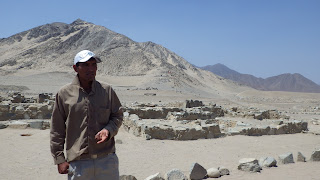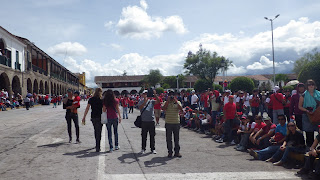It’s the end of
week 7; hard to believe, but I am rapidly approaching the two-month hurdle of
my semester in Peru. Time is both
dragging along and running away impossibly fast; days in Lima last forever, but
the weeks seem to fly by without me. The
first month was a blur: orientation, Semana Santa, and an epic battle with turista, but now I am finally starting
to hit my stride.
Speaking of
striding, I joined the PUCP equipo del Atletismo (the Católica track
team). The last thing I wanted to do
with my semester abroad was participate in organized sports, but I quickly
realized that if I really wanted to meet Peruvian students I was going to have
to put myself out there. And to be
honest, college sports in Peru are nothing like athletic programs in the
states; PUCP Atletismo is way more relaxed than even my middle school track team. I show up when I want to, and do what I want
to-kind of a perfect situation. We had a
time trial at 8:30 last Sunday at the Estadio Municipal Luis Gálvez Chipoco in
Barranco. My alarm clock didn’t work, so
my host mom and the Japanese nutritionist that has been living in my casita for
the past few weeks (a story for another day) woke me up at 8:35. I threw on sneakers and athletic clothes and
hit the sidewalk running; I showed up at the stadium 20 minutes later, sweating
and panting. Julia Martinich, the coach,
wasn’t surprised that I showed up over half an hour late, but was shocked that
I had decided to run to the stadium and that I showed up in good humor. Ten minutes later I ran el mil quinientos
(1500).
PUCP Atletismo last semester.
This week a fine
Bowdoin tradition made a trans continental debut. Yes, Wine Wednesday may have happened over
Skype. And I may or may not have
finished an entire bottle by myself.
After about two hours of talking with my favorite people I was ready to
go to bed, but Emma and Alec convinced me to get out of my pajamas and to go to
an event for exchange students (a gringo party in a gringo bar) in el Bar
Inglés near Parque Kennedy. I am truly
fortunate to have such a wonderful group of friends; they can even make me do things the things that are good for me from a different continent.
Who's got a bigger grin?
My women.
The IFSA program
course Realidad Social Peruana (RSP) incorporates 6 hours of volunteer work in
an NGO into the curriculum; I spend my time volunteering at the Huaca
Pucllana. I chose to not have class on Fridays only to end up devoting my free day to sorting organic material at
an archaeological site, but what can you do; if I actually had any free time I probably wouldn't know what to do with it. Unfortunately women aren’t allowed to excavate-delicate
sensibilities my ass-or I would be doing that.
Classifying artifacts is dull work; the bulk of the material consists of
corn (“Si hay duda, es maiz”), carrizo (bamboo), aji (pepper), cotton, leaves, spider
webs, insects etc. but every once in a while I’ll come across a gem such as a
bone or a small piece of textile. Every
time I get cranky I have to remind myself that it’s a great opportunity, and
there is some really interesting work going on at the site. This Friday, I met a thesis student from San
Marcos who is working with a Wari mummy; there is almost no red tape in Peru,
so I got to go into the lab to see the bones and the textile bag. Unreal!
This Friday
night was a good night to be a woman in Lima or at least it was in my
casita. I had a sleepover party (or
fiesta de pijamas) with two close friends from my program: Erin and
Adrienne. We ate cookie dough and
popcorn, gave each other hair wraps, drank red wine, and watched The First Wives Club. Embarrassing, but I literally think we hit on every feminine cliché. My host family was both amused and horrified. (“Están comiendo galletas crudas. Que asco, mis borrachitas.”) I think my sleep over was probable the most
foolish and girly thing that has ever happened in my house.
Guilt and pride.
Erin and Adrienne cooking bacon and eggs.
The next day
after an American breakfast Adrienne and I went to Playa de los Yuyos in
Barranco to try our hand at Outrigger canoeing. My
middle brother Alonso is on Inkanoa, the national team, and every Saturday
between 8:30 and 12:30 they have free sessions for beginners. By some weird combination of luck and
coincidence we arrived just in time to witness the baptism ceremony of a new
boat, a super sleek one-man scull. I went
out in two different boats; the first time the canoe capsized on the shore and
the second time the sea had grown to create some intimidating swells. Sitting in the second seat I had a bird’s eye
view of everything. Climbing up the faces of the waves and literally dropping down over
the backside was hands down the most exhilarating experience I’ve had in Lima. The guys on the team were extremely friendly;
they were all pretty excited that their sport was bringing gringas to the beach.
Baptizing the new boat.
Technique demonstration.
That afternoon
the IFSA gang headed to Huaca Pucllana for a tour (the same archaeological site
that I work at); our guide, the head archaeologist, had the wonderful
propensity of all archaeologists for focusing on the grotesque and mundane. Archaeologists consider dumps to be gold
mines; as such they have a charming fascination with all things gross and
quotidian. Our tour was both
illuminating and entertaining; perhaps most interesting is the organization of space in Lima. The city's multiple faces are in constant contrast and contact, and the Huaca is no exception. Right in the heart of Miraflores, this archaeological site is a reminder of Lima's past in the midst of its present and future.
The Huaca
is an adobe and clay pyramid located in Miraflores; the site was a ceremonial
and administrative center for the Lima culture, but there is also evidence of
habitation by the Wari and Ishma cultures.
We learned about the violent human sacrifices performed at the site
between 200 AD and 700 AD. Apparently,
the Lima culture was a matriarchal society; it was common practice to sacrifice
women of the ruling class to maintain control.
Que bacán!
Las chicas de la Huaca: Molly, Adrienne, and I.
Lima: past and present.
Julia and Erin.
La Plaza Central and Modern Concert Venue.
Saturday night
we indulged in all you can eat sushi and pisco sours. Sunday I went for a very long run; I have
been feeling really antsy living in Miraflores-at times it’s a little to upper
class and gringo for me-so I decided to explore Lima on foot. I watched the city change faces as I passed
through several of the countless districts of Lima: Miraflores, Surco,
Barranco, San Isidro, Magdalena del Mara, San Miguel, and Pueblo Libre. In the process I discovered that its takes me
less time to run to la Católica than it does subiendo en combi. Oh well, such is public transportation in
Lima.
Yum...








































